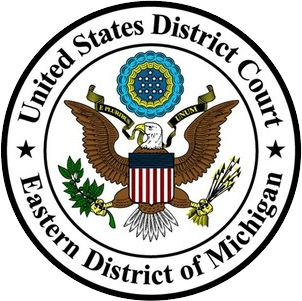Top Qs
Timeline
Chat
Perspective
United States District Court for the Eastern District of Michigan
United States federal district court in Michigan From Wikipedia, the free encyclopedia
Remove ads
The United States District Court for the Eastern District of Michigan (in case citations, E.D. Mich.) is the federal district court with jurisdiction over the eastern half of the Lower Peninsula of the State of Michigan. The Court is based in Detroit, with courthouses also located in Ann Arbor, Bay City, Flint, and Port Huron. The United States Court of Appeals for the Sixth Circuit has appellate jurisdiction over the court (except for patent claims and claims against the U.S. government under the Tucker Act, which are appealed to the Federal Circuit).


As of July 16, 2025[update], the acting United States attorney is Jerome F. Gorgon, Jr.
Remove ads
History
Summarize
Perspective
The United States District Court for the District of Michigan was established on July 1, 1836, by 5 Stat. 61, with a single judgeship.[1] The district court was not assigned to a judicial circuit, but was granted the same jurisdiction as United States circuit courts, except in appeals and writs of error, which were the jurisdiction of the Supreme Court. Due to the so-called "Toledo War", a boundary dispute with Ohio, Michigan did not become a state of the Union until January 26, 1837. On March 3, 1837, Congress passed an act that repealed the circuit court jurisdiction of the U.S. District Court for the District of Michigan, assigned the District of Michigan to the Seventh Circuit, and established a U.S. circuit court for the district, 5 Stat. 176.[1]
On July 15, 1862, Congress reorganized the circuits and assigned Michigan to the Eighth Circuit by 12 Stat. 576,[1] and on January 28, 1863, the Congress again reorganized Seventh and Eight Circuits and assigned Michigan to the Seventh Circuit, by 12 Stat. 637.[1] On February 24, 1863, Congress divided the District of Michigan into the Eastern and the Western Districts, with one judgeship authorized for each district, by 12 Stat. 660. Ross Wilkins, who had been the only district judge to serve the District of Michigan, was reassigned to the Eastern District.[1][2] Finally, on July 23, 1866, by 14 Stat. 209, Congress assigned the two Districts in Michigan to the Sixth Circuit, where they remain.[1]
Remove ads
Divisions
The Eastern District comprises two divisions.[3]
Northern Division
The Northern Division comprises the counties of Alcona, Alpena, Arenac, Bay, Cheboygan, Clare, Crawford, Gladwin, Gratiot, Huron, Iosco, Isabella, Midland, Montmorency, Ogemaw, Oscoda, Otsego, Presque Isle, Roscommon, Saginaw, and Tuscola.[3]
Southern Division
The Southern Division comprises the counties of Genesee, Jackson, Lapeer, Lenawee, Livingston, Macomb, Monroe, Oakland, Saint Clair, Sanilac, Shiawassee, Washtenaw, and Wayne.[3]
Court for the Southern Division is held in Ann Arbor, Detroit, Flint, and Port Huron.[3]
Remove ads
Notable cases
Some of the notable cases that have come before the United States District Court for the Eastern District of Michigan include:
- American Civil Liberties Union v. National Security Agency
- Berghuis v. Thompkins
- Conyers v. Bush
- Dean v. Utica Community Schools
- DeBoer v. Snyder
- Hess v. Reynolds
- Hosanna-Tabor Evangelical Lutheran Church & School v. Equal Employment Opportunity Commission
- KSR International Co. v. Teleflex Inc.
- R.G. & G.R. Harris Funeral Homes Inc. v. Equal Employment Opportunity Commission
- United States v. Abdulmutallab
- United States v. Anthony Chebatoris
- United States v. Detroit & Cleveland Navigation Co.
- United States v. Fieger
- United States v. Hathaway
- United States v. Kilpatrick
- United States v. Riverside Bayview
- United States v. Stone
- United States v. United States District Court
Current judges
Summarize
Perspective
As of July 28, 2025[update]:
Remove ads
Vacancies and pending nominations
Former judges
- Reassigned from the District of Michigan.
- Recess appointment; formally nominated on December 6, 1927, confirmed by the United States Senate on December 19, 1927, and received commission the same day.
- Recess appointment; formally nominated on January 15, 1962, confirmed by the Senate on February 5, 1962, and received commission on February 9, 1962.
Remove ads
Chief judges
Chief judges have administrative responsibilities with respect to their district court. Unlike the Supreme Court, where one justice is specifically nominated to be chief, the office of chief judge rotates among the district court judges. To be chief, a judge must have been in active service on the court for at least one year, be under the age of 65, and have not previously served as chief judge.
A vacancy is filled by the judge highest in seniority among the group of qualified judges. The chief judge serves for a term of seven years, or until age 70, whichever occurs first. The age restrictions are waived if no members of the court would otherwise be qualified for the position.
When the office was created in 1948, the chief judge was the longest-serving judge who had not elected to retire, on what has since 1958 been known as senior status, or declined to serve as chief judge. After August 6, 1959, judges could not become or remain chief after turning 70 years old. The current rules have been in operation since October 1, 1982.
Remove ads
Succession of seats
Summarize
Perspective
Remove ads
See also
References
External links
Wikiwand - on
Seamless Wikipedia browsing. On steroids.
Remove ads


